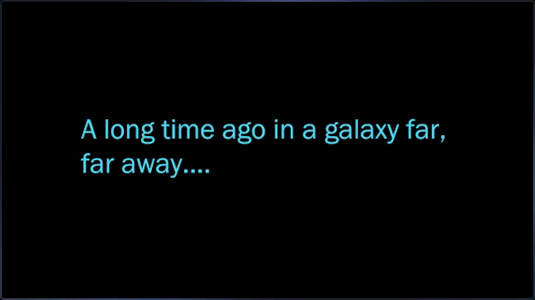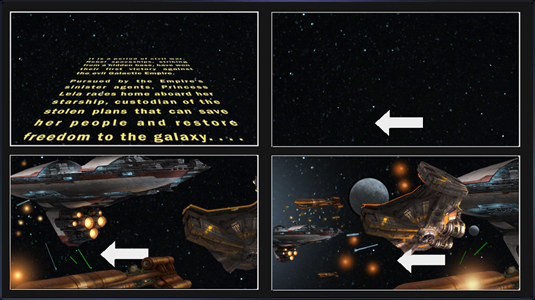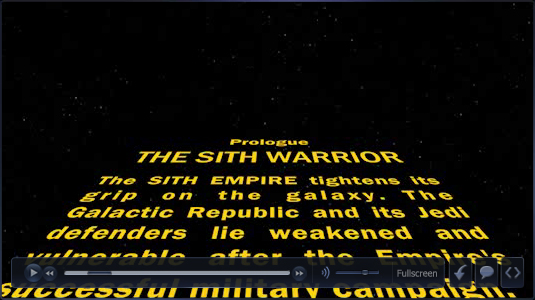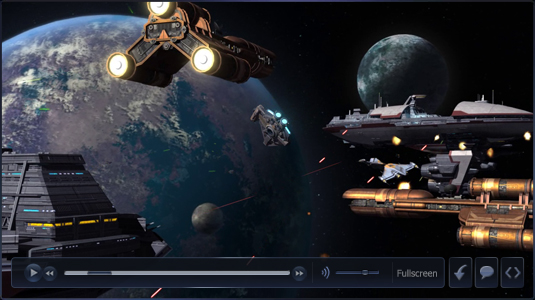News Articles
Studio Insider: Crafting the Class Intros
In this week’s Studio Insider, Senior Video Editor Brian Arndt takes us behind the scenes on the creation of the opening cinematics for each of the character classes. Be sure to also check out the Community Q&A, where Senior Audio Artist Scott Morton answers some of your questions relating to the audio production in Star Wars™: The Old Republic™.
Crafting the Class Intros
Hi, my name is Brian Arndt and I'm Senior Video Editor here at BioWare. I've been a huge fan of Star Wars™ since I was a little kid, and the one thing that I always remember in the theater was when everyone would get really quiet as a black screen appeared. Then suddenly you would see that familiar blue text: “A long time ago in a galaxy far, far away...” There’s that moment of anticipation before you’re blown away by the giant Star Wars logo! The epic Star Wars theme music blaring throughout the theater! Then the text fills you in on the story so far and begins its slow scrolling across the screen. It still excites me every time I see it as I know THIS is Star Wars that I'm watching.
Well, we are all proudly working on a Star Wars video game, a lifelong dream of mine and probably all of the team. What does the player need to see first to know they are about to play a part in the Star Wars universe? You guessed it!

As a part of the BioWare Creative Services team, we get to spend all our time in The Old Republic filming and editing gameplay walkthroughs, character progression videos, taking screenshots and even creating the Timeline video series. We work around the clock to deliver these Friday updates for the community (and even read your forum posts to see what people are looking forward to seeing and try and get them in there!). It's exciting and exhausting but a lot of fun, and the team is super passionate and proud to be doing it. So how did we end up crafting the class intro video assets for in-game, you might ask?
It began with a short discussion with Art Director Jeff Dobson where he asked if we could fit this into our (already insane) schedule. The answer was of course “We can't repel an offer of that magnitude!” Okay, it was more like “yes!” We decided to work nights, weekends, and through lunches to make it happen. With that settled, we rolled up our sleeves and set to work.
First step, research. We sat down and re-watched the opening sequences for all six movies to review how they were put together on a second-by-second basis. For most fans, the Star Wars crawl is just some scrolling yellow text that sets up the story. What you may not realize is that the format of this text has very precise guidelines, from the exact shade of yellow used in the font to the width of the margins and even down to the speed of the scroll.
We wound up using the opening crawl from The Empire Strikes Back as our template. Using text written by the writing team, we rendered out the crawl, got the color right, set the margins, and even timed out the speed. You know what wound up being the toughest part? The angle. Getting the angle at which the text floats off into space turned out to be more difficult than we anticipated. It took several iterations to get it just right.
Okay. The crawls are done. Now comes the fun part. Each movie transitions from the opening crawl to the scene where the camera pans from space to reveal a ship or a group of ships heading towards a planet. Senior Environmental Artist Clint Young started with this idea and drew up some storyboards to show how this could work. After reviewing those, we brainstormed with Clint, other artists, and Lead Cinematics Designer Paul Marino to start planning out the sequence in more detail. Since this is the first thing players will see in the game, we wanted players to know the instant they saw it that they were about to play a part in the Star Wars universe. Just like everything else at BioWare, quality always comes first.

Click the above image for a larger view.
To get the best quality, we couldn’t create these cinematics inside the game engine. The camera tools are too limited. But this still needed to be an “in-game” cinematic, so Associate Video Editor Brandon Miletta took the models from the game and dropped them into a CG animation rendering package. Then we started discussing what kind of scene would match what the in-game cinematics team had created on the planet's surface.
We wanted the scene for each class to have the traditional hallmarks of the Star Wars opening, but since each class in The Old Republic has a different story (and often start on a different world), the sequences were going to have to be customized. We decided to start with the Sith Warrior (and it wasn't a Sith biased approach I can assure you! I plan on playing Trooper!). The Cinematics team had already created a beautiful opening scene on Korriban showing the Warrior disembarking from a shuttle, so we knew that’s where the cinematic had to end, but where would it start? As always, when in doubt, consult the movies. Turned out that the opening scene from Return of the Jedi was very similar to what we wanted: a shuttle comes out of a Star Destroyer and heads towards the planet’s surface. Reconstructing that with our models took some time to get right. Another thing we had to take into account is that the skybox developed for Korriban depicts several Star Destroyers in orbit, so for the cinematic we added additional ships to populate the scene in space – that way when the player is on the surface and looks up they can see where they just descended from!

Now the Smuggler’s opening scene was even more complex. The story starts with the Smuggler having just ‘run’ a separatist blockade to deliver goods for Republic troops on Ord Mantell. The scene in space needed to reflect that. This was going to be more complicated than just a little shuttle ride. Brandon had to add models for Separatist and Republic ships which we took from in-game models, animate them in battle, and then have the Smuggler fly through. Since the Smuggler is also an ace pilot, it made sense to have him do some crazy space maneuvers as well—there’s nothing like a good old-fashioned “barrel roll”. Brandon had to go in and animate all this by hand, but it paid off.
After Brandon rendered out the scenes, the ball was in my court for the last steps. Taking the “rough” sequences for each of the classes, I went in and added visual effects: blaster fire, explosions, background ship battles, engine glows, and even a few lens flares for the engines. Incorporating suggestions from the art team, I also had to tweak the lighting and colors for the planets and the starfields so that everything looked just right for the final export.

Even when something is “final” at BioWare, it’s often not—not if it can be improved. Once we dropped the opening cinematics into the game, we opened a thread on the Game Testing forums to get feedback and suggestions. While the feedback was really positive overall, the testers had some interesting suggestions. Taking this feedback to heart, we went back to some of the scenes to add extra ships and to incorporate other tidbits. To illustrate, for the Sith Warrior intro, several people pointed out that the Star Destroyers in the background looked a little too static. So we animated and rendered out some new Star Destroyer models from the game. Some feedback we got was that the scene wasn't busy enough so Brandon inserted squadrons of Sith fighters, adding a new layer to the scene as a whole, and to drive it to be the highest quality we could.
Developing the text crawls and intro scenes for each of the classes was a blast for us. We so often create videos and trailers to show off all the awesome work our colleagues have developed in the game, so it was very cool for us to use those same skills to contribute something to the in-game experience as well. Like everyone else here, it's amazing to just come into work every day and do what we do. We hope that you’ll enjoy the experience as much as we’ve enjoyed creating it.
Look forward to seeing you all soon in a galaxy far, far away.
Community Q&A
The Star Wars: The Old Republic community is eager for new information, and we want to answer as many of your questions as possible. Next month’s Q&A will focus on questions regarding player versus player combat (PVP) in The Old Republic. If you have any questions, don’t hesitate to ask via our Forums or on Facebook. Make sure to get your questions to us no later than July 22nd if you want to be considered for the next Community Q&A.
Today, Senior Audio Artist Scott Morton answers a few of your questions about sound design in The Old Republic.
Q: Will the NPCs have monologues or dialogues with each other that players can hear while walking nearby? – mmZero
A: Yes, they will. As in other BioWare games, ambient conversation is a part of the world and will help the player tune into the general goings-on of his or her surrounding area. Companions will sometimes voice their thoughts and opinions as well, as you travel the different worlds in The Old Republic.
Q: Are the voices used in the class videos just a storyteller or is that the voice of the actual character in-game? - Verico
A: When a player class is speaking a line or narrating in the class videos, you’re hearing the voice of the actual actor who will be filling that role. We’ve worked closely with LucasArts to cast voice actors that are able to capture the essence of each class, and help players identify with their characters on a deeper level.
Q: Are we able to switch the different sounds louder and quieter as we please? For example, turning off sounds of voices while the background music is still on? – Blumilein
A: Yes. Players will be able to set their own audio levels when it comes to voice, music, ambience, and sound effects. Being able to customize your mix and your experience is important.
Q: How many voice actors voiced this game? – DigitalMaster
A: We are working with a very large number of voice actors… possibly more than any other game made so far. Recent counts put the number at over nine hundred actors across all three languages, and that number is still growing.
Q: What percentage of the in-game music is original for The Old Republic and what percentage has already been used elsewhere (movies, other games, etc.)? – Nahte
A: We’ve written a huge amount of original music for the game. There are over six hours of original score that have been produced specifically for The Old Republic, plus an additional hour and a half of brand new cantina music. In addition to the original score, you’ll also hear the scores for both Knights of the Old Republic I and Knights of the Old Republic II. Lastly, the game just wouldn’t be complete without John Williams’ material from the Star Wars films.
Q: Will special ability sounds change as you upgrade your weapons, or will they stay consistent throughout the leveling process? For instance, the Trooper’s ability that launches a grenade - you get this fairly early on with your basic equipment, but will it sound the same at end-game with an epic rifle? – Noobinator
A: Certain abilities will have fixed, signature sounds while others will dynamically change based on the weapons you have equipped. When you loot a new Lightsaber or blaster, you’ll notice that it almost always makes different sounds than the one you were previously using. We’re really happy about how weapon sounds can blend with your abilities to make your combat sound unique. Rare weapons are even more special – you may find a rare weapon that also has a rare and more powerful set of sounds associated with it.
Q: Does The Old Republic use any of Ben Burrt's original sound effects from the films? – MorgonKara
A: We’re definitely tapping into some of Ben Burtt’s classic material and integrating it into the game in different ways, sometimes as a layering approach and sometimes processing it to make something new. You’ll definitely hear some of his original material from the films too (it wouldn’t be Star Wars without it)!
Q: Will the Mos Eisley cantina music be in the game? – ChavekToth
A: Peter McConnell, Jared Emerson-Johnson, and Steve Kirk have written an hour and a half of brand new cantina music for The Old Republic. The goal was to expand off of the existing material we’ve all heard and try to fill out the rest of the set list. If you were to hang out in the Mos Eisley Cantina, what would the remainder of Figrin D’an and the Modal Nodes’ concert have sounded like? What does a longer set sound like from The Max Rebo Band? What kind of music might you hear in an Imperial cantina? It all grew out of the cantina music in the original films. But, keep your ears open for those few classic tunes, too; I’m sure they’ll turn up somewhere!
Q: Is there any dynamic use of sound or music? Maybe on certain boss mobs, when your health gets lower (or the group's total health), or when you come upon a certain viewpoint? - Unknown
A: Our music system is dynamic and very responsive to gameplay situations. We’re also doing some cool things with some of the combat sound to make movement, foley and weapons more varied and alive.
Q: Do bad guys (Darth Malgus, etc.) get their own cool theme songs? - ZeroGravTrooper
A: The music of Star Wars is definitely rooted in the tradition of representing characters with themes, and the music in The Old Republic is no different. The approach we’ve taken, however, varies slightly in that classes and locations have themes within The Old Republic, rather than trying to score every single specific character. As such, a Jedi would have a different musical experience than a Smuggler because they each have their own unique class themes woven throughout their stories. They also begin on different origin worlds which in turn have their own themes and unique music.
Q: How is the music “playlist” handled? For example, when traveling from one location to another, how does the music fade or change at the end of every song? - Altheran
A: Our music system is adaptive and is designed to respond based on what you’re doing and where you’re going. If you’re entering a cinematic conversation, the music will smoothly adjust and follow the dramatic events of that scene. If you’re exploring the world, music will highlight points of interest, and shift into a more ambient role when necessary. The music will also respond appropriately based on what sort of choices you make and actions you take in a conversation. Our goal with music is to always support the situation you’re in without compromising overall musical flow and integrity.
Thanks for joining us for this Studio Insider! We hope you enjoyed the inside look at the opening class cinematics from Brian Arndt, as well as the Q&A with Scott Morton. We know you have a lot of questions, so we’ve opened a new Community Q&A thread relating to PVP in The Old Republic.



